SQLCLR系列文章
SQLCLR(一)入门
 exec
sp_configure
'
clr enabled
'
--
查看状态
exec
sp_configure
'
clr enabled
'
--
查看状态
 exec
sp_configure
'
clr enabled
'
,
1
--
1,启用clr\0,禁用clr
exec
sp_configure
'
clr enabled
'
,
1
--
1,启用clr\0,禁用clr
 reconfigure
with
override
--
按提示(配置选项 'clr enabled' 已从 0 更改为 1。请运行 RECONFIGURE 语句进行安装。)运行此句
reconfigure
with
override
--
按提示(配置选项 'clr enabled' 已从 0 更改为 1。请运行 RECONFIGURE 语句进行安装。)运行此句
 using
System;
using
System;
 using
System.Data;
using
System.Data;
 using
System.Data.SqlClient;
using
System.Data.SqlClient;
 using
System.Data.SqlTypes;
using
System.Data.SqlTypes;
 using
Microsoft.SqlServer.Server;
using
Microsoft.SqlServer.Server;

 public
partial
class
UserDefinedFunctions
public
partial
class
UserDefinedFunctions


 {
{
 [Microsoft.SqlServer.Server.SqlFunction]
[Microsoft.SqlServer.Server.SqlFunction]
 public static SqlString TestFunction(string input)
public static SqlString TestFunction(string input)


 {
{
 // 在此处放置代码
// 在此处放置代码
 return "hello," + input;
return "hello," + input;
 }
}
 }
;
}
;


 SELECT
[
dbo
]
.
[
TestFunction
]
(
'
david fan
'
)
SELECT
[
dbo
]
.
[
TestFunction
]
(
'
david fan
'
)
SQL Server 2005发布后,可以编写出能够在SQL Server中运行的.net代码了。同IIS一样,SQL Server 2005也是.net程序的宿主。
首先安装sqlserver2005和visual studio 2005。启用sqlserver2005的clr ,应先在sqlsever的查询分析器按实际情况执行下边的语句
 exec
sp_configure
'
clr enabled
'
--
查看状态
exec
sp_configure
'
clr enabled
'
--
查看状态
 exec
sp_configure
'
clr enabled
'
,
1
--
1,启用clr\0,禁用clr
exec
sp_configure
'
clr enabled
'
,
1
--
1,启用clr\0,禁用clr
 reconfigure
with
override
--
按提示(配置选项 'clr enabled' 已从 0 更改为 1。请运行 RECONFIGURE 语句进行安装。)运行此句
reconfigure
with
override
--
按提示(配置选项 'clr enabled' 已从 0 更改为 1。请运行 RECONFIGURE 语句进行安装。)运行此句
快速开发的方法莫过于直接使用visual studio 2005。
第一步,打vs新建项目类型-数据库-SQL Server项目。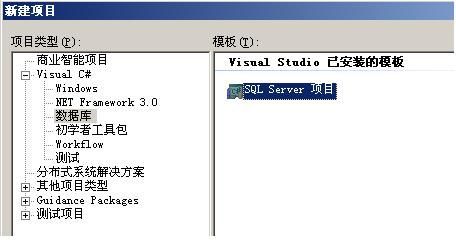
第二步,数据库引用连接。如果没有可选连接,可以添加新连接。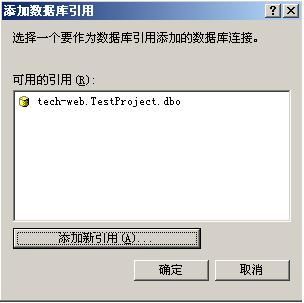
点添加新引用按钮,添加新的连接。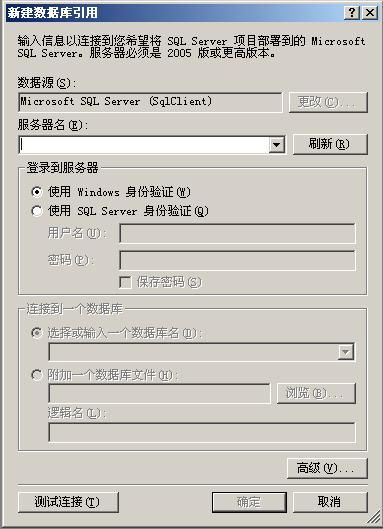
第三步,现在可以添加用户自定义类型(UDT)、存储过程、用户自定义函数、聚合和触发器中的任意一种了。
现在动手做一个小的自定义函数的例子。
添加一个"用户定义的函数(F)",
 using
System;
using
System; using
System.Data;
using
System.Data; using
System.Data.SqlClient;
using
System.Data.SqlClient; using
System.Data.SqlTypes;
using
System.Data.SqlTypes; using
Microsoft.SqlServer.Server;
using
Microsoft.SqlServer.Server;
 public
partial
class
UserDefinedFunctions
public
partial
class
UserDefinedFunctions

 {
{ [Microsoft.SqlServer.Server.SqlFunction]
[Microsoft.SqlServer.Server.SqlFunction] public static SqlString TestFunction(string input)
public static SqlString TestFunction(string input)

 {
{ // 在此处放置代码
// 在此处放置代码 return "hello," + input;
return "hello," + input; }
} }
;
}
;

项目右键-部署,状态栏显示部署成功后,在sqlserver2005 查询分析器选择对应的数据库执行下面的语句。
 SELECT
[
dbo
]
.
[
TestFunction
]
(
'
david fan
'
)
SELECT
[
dbo
]
.
[
TestFunction
]
(
'
david fan
'
)
结果如下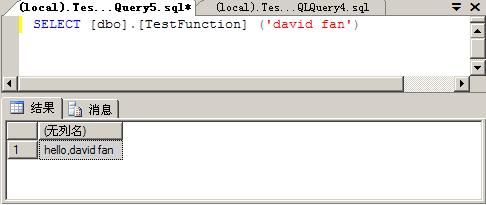
SQLCLR(二)存储过程和自定义函数
自定义函数和存储过程在.net里其实都是方法。只是方法上方标注[Microsoft.SqlServer.Server.SqlProcedure]
和[Microsoft.SqlServer.Server.SqlFunction]不同而已。自定义函数又分TVF函数和Scalar两种,最大区别在于TVF返回表后者返回Scalar(标量),这一篇我们做一下比较。
先看两段代码
存储过程:
 using
System;
using
System;
 using
System.Data;
using
System.Data;
 using
System.Data.SqlClient;
using
System.Data.SqlClient;
 using
System.Data.SqlTypes;
using
System.Data.SqlTypes;
 using
Microsoft.SqlServer.Server;
using
Microsoft.SqlServer.Server;


 public
partial
class
StoredProcedures
public
partial
class
StoredProcedures


 {
{
 //这里是告诉sqlserver,这个方法要注册成存储过程
//这里是告诉sqlserver,这个方法要注册成存储过程
 //我感觉[Attribute]这个东西翻译成标签更形像:)
//我感觉[Attribute]这个东西翻译成标签更形像:)
 [Microsoft.SqlServer.Server.SqlProcedure]
[Microsoft.SqlServer.Server.SqlProcedure]
 public static void TestStoredProcedure(string name, ref string outstr)
public static void TestStoredProcedure(string name, ref string outstr)


 {
{
 // 在此处放置代码
// 在此处放置代码
 outstr = "hello," + name;
outstr = "hello," + name;

 using (SqlConnection cn = new SqlConnection())
using (SqlConnection cn = new SqlConnection())


 {
{
 //使用上下文链接也就是当前数据库链接
//使用上下文链接也就是当前数据库链接
 cn.ConnectionString = "context connection=true";
cn.ConnectionString = "context connection=true";
 using (SqlCommand cmd = cn.CreateCommand())
using (SqlCommand cmd = cn.CreateCommand())


 {
{
 cmd.CommandText = "Select * from userinfo";
cmd.CommandText = "Select * from userinfo";
 cn.Open();
cn.Open();
 //SqlContext.Pipe.Send这个方法输出结果集
//SqlContext.Pipe.Send这个方法输出结果集
 //接受SqlDataReader,SqlDataRecord和string
//接受SqlDataReader,SqlDataRecord和string
 SqlContext.Pipe.Send(cmd.ExecuteReader());
SqlContext.Pipe.Send(cmd.ExecuteReader());
 //你也可以用下边这样
//你也可以用下边这样
 //SqlContext.Pipe.ExecuteAndSend(cmd);
//SqlContext.Pipe.ExecuteAndSend(cmd);
 }
}
 }
}
 }
}
 }
;
}
;
 执行存储过程
执行存储过程
 DECLARE
@name
nvarchar
(
4000
)
DECLARE
@name
nvarchar
(
4000
)
 DECLARE
@outstr
nvarchar
(
4000
)
DECLARE
@outstr
nvarchar
(
4000
)
 set
@name
=
'
david fan
'
set
@name
=
'
david fan
'
 --
TODO: 在此处设置参数值。
--
TODO: 在此处设置参数值。
 EXECUTE
[
TestProject
]
.
[
dbo
]
.
[
TestStoredProcedure
]
EXECUTE
[
TestProject
]
.
[
dbo
]
.
[
TestStoredProcedure
]
 @name
@name
 ,
@outstr
OUTPUT
,
@outstr
OUTPUT
 print
@outstr
print
@outstr
结果如下
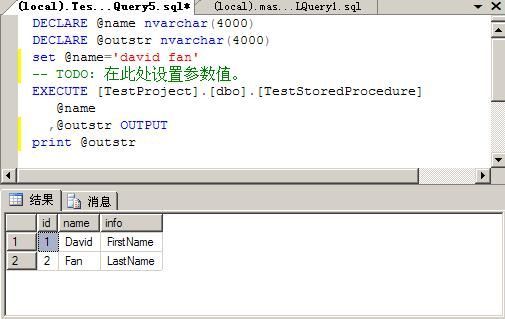
输出参数返回值
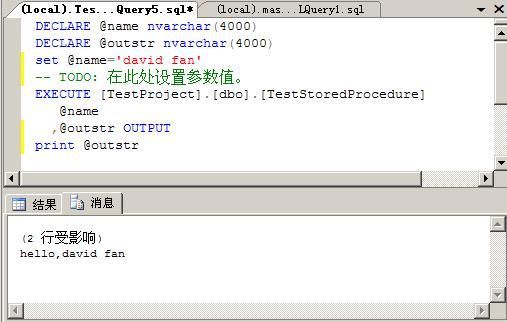
自定义函数
一,TVF函数
示例函数的作用是搜索目录下的某一类型的文件
 using
System;
using
System;
 using
System.Data;
using
System.Data;
 using
System.Data.Sql;
using
System.Data.Sql;
 using
System.Data.SqlTypes;
using
System.Data.SqlTypes;
 using
Microsoft.SqlServer.Server;
using
Microsoft.SqlServer.Server;
 using
System.Collections;
using
System.Collections;
 using
System.IO;
using
System.IO;
 using
System.Security.Principal;
using
System.Security.Principal;

 public
partial
class
UserDefinedFunctions
public
partial
class
UserDefinedFunctions


 {
{
 //需要返回一个表时用TVF(streaming table-valued function)
//需要返回一个表时用TVF(streaming table-valued function)
 //可以用select from 语句查询这个方法的返回
//可以用select from 语句查询这个方法的返回
 //TVF需要返回Ienumerable接口,例如:Array,这里返回一个数组
//TVF需要返回Ienumerable接口,例如:Array,这里返回一个数组

 //FillRowMethodName为填充表行的方法
//FillRowMethodName为填充表行的方法
 //TableDefinition为表结构,对应FillRowMethodName方法的参数
//TableDefinition为表结构,对应FillRowMethodName方法的参数
 [Microsoft.SqlServer.Server.SqlFunction(FillRowMethodName = "BuildRow",
[Microsoft.SqlServer.Server.SqlFunction(FillRowMethodName = "BuildRow",
 TableDefinition = "Name nvarchar(32), Length bigint, Modified DateTime")]
TableDefinition = "Name nvarchar(32), Length bigint, Modified DateTime")]
 public static IEnumerable FileListCs(string directoryName, string pattern)
public static IEnumerable FileListCs(string directoryName, string pattern)


 {
{
 FileInfo[] files;
FileInfo[] files;
 //模拟当前SQL安全上下文
//模拟当前SQL安全上下文
 WindowsImpersonationContext OriginalContext= SqlContext.WindowsIdentity.Impersonate();
WindowsImpersonationContext OriginalContext= SqlContext.WindowsIdentity.Impersonate();
 try
try


 {
{
 DirectoryInfo di = new DirectoryInfo(directoryName);
DirectoryInfo di = new DirectoryInfo(directoryName);
 files = di.GetFiles(pattern);
files = di.GetFiles(pattern);
 }
}
 finally
finally


 {
{
 if (OriginalContext != null)
if (OriginalContext != null)


 {
{
 OriginalContext.Undo();
OriginalContext.Undo();
 }
}
 }
}
 return files;
return files;
 }
}

 public static void BuildRow(object Obj,
public static void BuildRow(object Obj,
 ref SqlString fileName,
ref SqlString fileName,
 ref SqlInt64 fileLength,
ref SqlInt64 fileLength,
 ref SqlDateTime fileModified)
ref SqlDateTime fileModified)


 {
{
 if (Obj != null)
if (Obj != null)


 {
{
 FileInfo file = (FileInfo)Obj;
FileInfo file = (FileInfo)Obj;
 fileName = file.Name;
fileName = file.Name;
 fileLength = file.Length;
fileLength = file.Length;
 fileModified = file.LastWriteTime;
fileModified = file.LastWriteTime;
 }
}
 else
else


 {
{
 fileName = SqlString.Null;
fileName = SqlString.Null;
 fileLength = SqlInt64.Null;
fileLength = SqlInt64.Null;
 fileModified = SqlDateTime.Null;
fileModified = SqlDateTime.Null;
 }
}
 }
}
 }
因为这个函数对于sqlserver来讲要访问外部资源,所以需要配置一下项目和sqlserver2005
}
因为这个函数对于sqlserver来讲要访问外部资源,所以需要配置一下项目和sqlserver2005
项目右键 属性, 数据库,权限级别选 外部
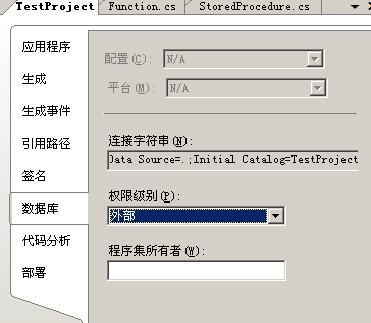
打开sqlserver2005查询分析器执行下边语句 TestProject 为我的数据库名,你的如果不是,当然需要修改了。
 ALTER
DATABASE
TestProject
SET
TRUSTWORTHY
ON
;
成功后,项目右键
部署。
ALTER
DATABASE
TestProject
SET
TRUSTWORTHY
ON
;
成功后,项目右键
部署。
查询分析器中执行
 SELECT
*
FROM
[
TestProject
]
.
[
dbo
]
.
[
FileListCs
]
(
SELECT
*
FROM
[
TestProject
]
.
[
dbo
]
.
[
FileListCs
]
(
 '
c:\
'
'
c:\
'
 ,
'
*.txt
'
)
结果如下
,
'
*.txt
'
)
结果如下
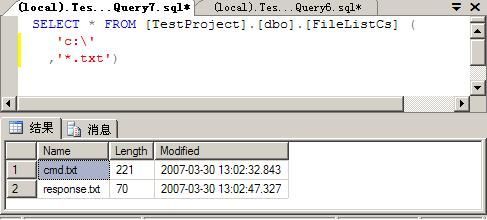
二,Scalar 函数
这类函数返回类型如图,像SqlString这类sqlserver的scalar类型
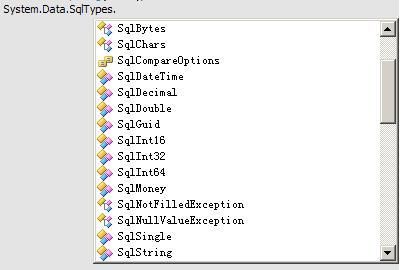
下面就是这类函数的一个小例子。
 using
System;
using
System;
 using
System.Data;
using
System.Data;
 using
System.Data.SqlClient;
using
System.Data.SqlClient;
 using
System.Data.SqlTypes;
using
System.Data.SqlTypes;
 using
Microsoft.SqlServer.Server;
using
Microsoft.SqlServer.Server;

 public
partial
class
UserDefinedFunctions
public
partial
class
UserDefinedFunctions


 {
{
 [Microsoft.SqlServer.Server.SqlFunction]
[Microsoft.SqlServer.Server.SqlFunction]
 public static SqlString ScalarFunction()
public static SqlString ScalarFunction()


 {
{
 // 在此处放置代码
// 在此处放置代码
 return new SqlString("Hello");
return new SqlString("Hello");
 }
}
 }
;
sqlserver查询查询分析器中运行如下语句
}
;
sqlserver查询查询分析器中运行如下语句
 SELECT
[
TestProject
]
.
[
dbo
]
.
[
ScalarFunction
]
()
结果如下
SELECT
[
TestProject
]
.
[
dbo
]
.
[
ScalarFunction
]
()
结果如下
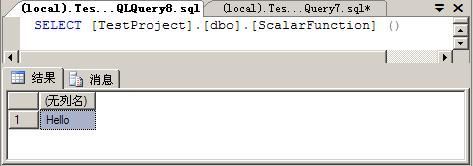
和[Microsoft.SqlServer.Server.SqlFunction]不同而已。自定义函数又分TVF函数和Scalar两种,最大区别在于TVF返回表后者返回Scalar(标量),这一篇我们做一下比较。
先看两段代码
存储过程:
 using
System;
using
System; using
System.Data;
using
System.Data; using
System.Data.SqlClient;
using
System.Data.SqlClient; using
System.Data.SqlTypes;
using
System.Data.SqlTypes; using
Microsoft.SqlServer.Server;
using
Microsoft.SqlServer.Server;

 public
partial
class
StoredProcedures
public
partial
class
StoredProcedures

 {
{ //这里是告诉sqlserver,这个方法要注册成存储过程
//这里是告诉sqlserver,这个方法要注册成存储过程 //我感觉[Attribute]这个东西翻译成标签更形像:)
//我感觉[Attribute]这个东西翻译成标签更形像:) [Microsoft.SqlServer.Server.SqlProcedure]
[Microsoft.SqlServer.Server.SqlProcedure] public static void TestStoredProcedure(string name, ref string outstr)
public static void TestStoredProcedure(string name, ref string outstr)

 {
{ // 在此处放置代码
// 在此处放置代码 outstr = "hello," + name;
outstr = "hello," + name;
 using (SqlConnection cn = new SqlConnection())
using (SqlConnection cn = new SqlConnection())

 {
{ //使用上下文链接也就是当前数据库链接
//使用上下文链接也就是当前数据库链接 cn.ConnectionString = "context connection=true";
cn.ConnectionString = "context connection=true"; using (SqlCommand cmd = cn.CreateCommand())
using (SqlCommand cmd = cn.CreateCommand())

 {
{ cmd.CommandText = "Select * from userinfo";
cmd.CommandText = "Select * from userinfo"; cn.Open();
cn.Open(); //SqlContext.Pipe.Send这个方法输出结果集
//SqlContext.Pipe.Send这个方法输出结果集 //接受SqlDataReader,SqlDataRecord和string
//接受SqlDataReader,SqlDataRecord和string SqlContext.Pipe.Send(cmd.ExecuteReader());
SqlContext.Pipe.Send(cmd.ExecuteReader()); //你也可以用下边这样
//你也可以用下边这样 //SqlContext.Pipe.ExecuteAndSend(cmd);
//SqlContext.Pipe.ExecuteAndSend(cmd); }
} }
} }
} }
;
}
;
 DECLARE
@name
nvarchar
(
4000
)
DECLARE
@name
nvarchar
(
4000
) DECLARE
@outstr
nvarchar
(
4000
)
DECLARE
@outstr
nvarchar
(
4000
) set
@name
=
'
david fan
'
set
@name
=
'
david fan
'
 --
TODO: 在此处设置参数值。
--
TODO: 在此处设置参数值。
 EXECUTE
[
TestProject
]
.
[
dbo
]
.
[
TestStoredProcedure
]
EXECUTE
[
TestProject
]
.
[
dbo
]
.
[
TestStoredProcedure
]
 @name
@name
 ,
@outstr
OUTPUT
,
@outstr
OUTPUT print
@outstr
print
@outstr
结果如下

输出参数返回值

自定义函数
一,TVF函数
示例函数的作用是搜索目录下的某一类型的文件
 using
System;
using
System; using
System.Data;
using
System.Data; using
System.Data.Sql;
using
System.Data.Sql; using
System.Data.SqlTypes;
using
System.Data.SqlTypes; using
Microsoft.SqlServer.Server;
using
Microsoft.SqlServer.Server; using
System.Collections;
using
System.Collections; using
System.IO;
using
System.IO; using
System.Security.Principal;
using
System.Security.Principal;
 public
partial
class
UserDefinedFunctions
public
partial
class
UserDefinedFunctions

 {
{ //需要返回一个表时用TVF(streaming table-valued function)
//需要返回一个表时用TVF(streaming table-valued function) //可以用select from 语句查询这个方法的返回
//可以用select from 语句查询这个方法的返回 //TVF需要返回Ienumerable接口,例如:Array,这里返回一个数组
//TVF需要返回Ienumerable接口,例如:Array,这里返回一个数组
 //FillRowMethodName为填充表行的方法
//FillRowMethodName为填充表行的方法 //TableDefinition为表结构,对应FillRowMethodName方法的参数
//TableDefinition为表结构,对应FillRowMethodName方法的参数 [Microsoft.SqlServer.Server.SqlFunction(FillRowMethodName = "BuildRow",
[Microsoft.SqlServer.Server.SqlFunction(FillRowMethodName = "BuildRow", TableDefinition = "Name nvarchar(32), Length bigint, Modified DateTime")]
TableDefinition = "Name nvarchar(32), Length bigint, Modified DateTime")] public static IEnumerable FileListCs(string directoryName, string pattern)
public static IEnumerable FileListCs(string directoryName, string pattern)

 {
{ FileInfo[] files;
FileInfo[] files; //模拟当前SQL安全上下文
//模拟当前SQL安全上下文 WindowsImpersonationContext OriginalContext= SqlContext.WindowsIdentity.Impersonate();
WindowsImpersonationContext OriginalContext= SqlContext.WindowsIdentity.Impersonate(); try
try

 {
{ DirectoryInfo di = new DirectoryInfo(directoryName);
DirectoryInfo di = new DirectoryInfo(directoryName); files = di.GetFiles(pattern);
files = di.GetFiles(pattern); }
} finally
finally

 {
{ if (OriginalContext != null)
if (OriginalContext != null)

 {
{ OriginalContext.Undo();
OriginalContext.Undo(); }
} }
} return files;
return files; }
}
 public static void BuildRow(object Obj,
public static void BuildRow(object Obj, ref SqlString fileName,
ref SqlString fileName, ref SqlInt64 fileLength,
ref SqlInt64 fileLength, ref SqlDateTime fileModified)
ref SqlDateTime fileModified)

 {
{ if (Obj != null)
if (Obj != null)

 {
{ FileInfo file = (FileInfo)Obj;
FileInfo file = (FileInfo)Obj; fileName = file.Name;
fileName = file.Name; fileLength = file.Length;
fileLength = file.Length; fileModified = file.LastWriteTime;
fileModified = file.LastWriteTime; }
} else
else

 {
{ fileName = SqlString.Null;
fileName = SqlString.Null; fileLength = SqlInt64.Null;
fileLength = SqlInt64.Null; fileModified = SqlDateTime.Null;
fileModified = SqlDateTime.Null; }
} }
} }
}
项目右键 属性, 数据库,权限级别选 外部

打开sqlserver2005查询分析器执行下边语句 TestProject 为我的数据库名,你的如果不是,当然需要修改了。
 ALTER
DATABASE
TestProject
SET
TRUSTWORTHY
ON
;
ALTER
DATABASE
TestProject
SET
TRUSTWORTHY
ON
;
查询分析器中执行
 SELECT
*
FROM
[
TestProject
]
.
[
dbo
]
.
[
FileListCs
]
(
SELECT
*
FROM
[
TestProject
]
.
[
dbo
]
.
[
FileListCs
]
( '
c:\
'
'
c:\
'
 ,
'
*.txt
'
)
,
'
*.txt
'
)

二,Scalar 函数
这类函数返回类型如图,像SqlString这类sqlserver的scalar类型

下面就是这类函数的一个小例子。
 using
System;
using
System; using
System.Data;
using
System.Data; using
System.Data.SqlClient;
using
System.Data.SqlClient; using
System.Data.SqlTypes;
using
System.Data.SqlTypes; using
Microsoft.SqlServer.Server;
using
Microsoft.SqlServer.Server;
 public
partial
class
UserDefinedFunctions
public
partial
class
UserDefinedFunctions

 {
{ [Microsoft.SqlServer.Server.SqlFunction]
[Microsoft.SqlServer.Server.SqlFunction] public static SqlString ScalarFunction()
public static SqlString ScalarFunction()

 {
{ // 在此处放置代码
// 在此处放置代码 return new SqlString("Hello");
return new SqlString("Hello"); }
} }
;
}
;
 SELECT
[
TestProject
]
.
[
dbo
]
.
[
ScalarFunction
]
()
SELECT
[
TestProject
]
.
[
dbo
]
.
[
ScalarFunction
]
()

SQLCLR(三)触发器
这一节比较简单了,主要是讲如何在SQLCLR下设计触发器。在SQLServer2005里分两种触发器,DDL和DML两种触发器。DDL触发器是响应CREATE、ALTER 和 DROP 开头的语句。我们常用的是DML触发器,这一类触发器响应当数据库中发生数据操作包括表或视图中修改数据的 INSERT 、UPDATE 或 DELETE 。
对于.net来讲触发器也是方法,在上方标注[Microsoft.SqlServer.Server.SqlTrigger]标签(只我这样翻译)。
我们看一个小例子
 using
System;
using
System;
 using
System.Data;
using
System.Data;
 using
System.Data.Sql;
using
System.Data.Sql;
 using
Microsoft.SqlServer.Server;
using
Microsoft.SqlServer.Server;
 using
System.Data.SqlClient;
using
System.Data.SqlClient;

 public
partial
class
Triggers
public
partial
class
Triggers


 {
{
 //Name触发器的名字
//Name触发器的名字
 //Target触发器对应表
//Target触发器对应表
 //Event可以是{ FOR | AFTER | INSTEAD OF } { [ INSERT ] [ , ] [ UPDATE ] [ , ] [ DELETE ] }
//Event可以是{ FOR | AFTER | INSTEAD OF } { [ INSERT ] [ , ] [ UPDATE ] [ , ] [ DELETE ] }
 [Microsoft.SqlServer.Server.SqlTrigger(Name = "NameInfoTrigger", Target = "NameInfo", Event = "FOR UPDATE")]
[Microsoft.SqlServer.Server.SqlTrigger(Name = "NameInfoTrigger", Target = "NameInfo", Event = "FOR UPDATE")]
 public static void GetChange()
public static void GetChange()


 {
{
 using (SqlConnection cn = new SqlConnection())
using (SqlConnection cn = new SqlConnection())


 {
{
 cn.ConnectionString = "context connection=true";
cn.ConnectionString = "context connection=true";
 cn.Open();
cn.Open();
 using (SqlCommand cmd = cn.CreateCommand())
using (SqlCommand cmd = cn.CreateCommand())


 {
{
 cmd.CommandText = "insert into ChangeHistory select b.name + '->' + a.name,getdate() from INSERTED a JOIN DELETED b ON a.id = b.id";
cmd.CommandText = "insert into ChangeHistory select b.name + '->' + a.name,getdate() from INSERTED a JOIN DELETED b ON a.id = b.id";
 SqlContext.Pipe.ExecuteAndSend(cmd);
SqlContext.Pipe.ExecuteAndSend(cmd);
 }
}
 }
}
 }
}
 }
}

右键部署
数据库里的两张表
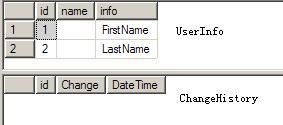
我执行两条UPDATE语句
 update
[
NameInfo
]
set
[
name
]
=
'
David
'
where
id
=
1
update
[
NameInfo
]
set
[
name
]
=
'
David
'
where
id
=
1
 update
[
nameinfo
]
set
[
name
]
=
'
Fan
'
where
id
=
2
结果
update
[
nameinfo
]
set
[
name
]
=
'
Fan
'
where
id
=
2
结果

再执行两条
 update
[
NameInfo
]
set
[
name
]
=
'
*David*
'
where
id
=
1
update
[
NameInfo
]
set
[
name
]
=
'
*David*
'
where
id
=
1
 update
[
nameinfo
]
set
[
name
]
=
'
*Fan*
'
where
id
=
2
再看结果
update
[
nameinfo
]
set
[
name
]
=
'
*Fan*
'
where
id
=
2
再看结果
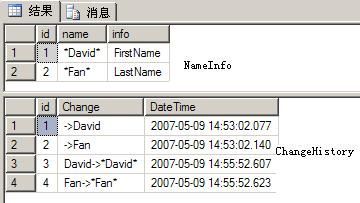
 using
System;
using
System;
 using
System.IO;
using
System.IO;
 using
System.Data;
using
System.Data;
 using
System.Data.SqlClient;
using
System.Data.SqlClient;
 using
System.Data.SqlTypes;
using
System.Data.SqlTypes;
 using
Microsoft.SqlServer.Server;
using
Microsoft.SqlServer.Server;

 [Serializable]
[Serializable]
 [Microsoft.SqlServer.Server.SqlUserDefinedType(Format.UserDefined, MaxByteSize
=
1024
)]
[Microsoft.SqlServer.Server.SqlUserDefinedType(Format.UserDefined, MaxByteSize
=
1024
)]
 public
struct
Person : INullable, IBinarySerialize
public
struct
Person : INullable, IBinarySerialize


 {
{
 public override string ToString()
public override string ToString()


 {
{
 // 用您的代码替换下列代码
// 用您的代码替换下列代码
 return FormatU();
return FormatU();
 }
}

 public bool IsNull
public bool IsNull


 {
{
 get
get


 {
{
 // 在此处放置代码
// 在此处放置代码
 return m_Null;
return m_Null;
 }
}
 }
}

 public static Person Null
public static Person Null


 {
{
 get
get


 {
{
 Person h = new Person();
Person h = new Person();
 h.m_Null = true;
h.m_Null = true;
 return h;
return h;
 }
}
 }
}

 public static Person Parse(SqlString s)
public static Person Parse(SqlString s)


 {
{
 if (s.IsNull)
if (s.IsNull)
 return Null;
return Null;

 Person u = new Person();
Person u = new Person();
 string value = s.Value;
string value = s.Value;
 if (value == "null") return Null;
if (value == "null") return Null;

 string[] parts = value.Split(',');
string[] parts = value.Split(',');
 u.name = parts[0];
u.name = parts[0];
 u.age = ParseAge(parts[1]);
u.age = ParseAge(parts[1]);
 u.sex = parts[2];
u.sex = parts[2];
 return u;
return u;
 }
}

 // 这是占位符方法
// 这是占位符方法
 public string FormatU()
public string FormatU()


 {
{
 //在此处插入方法代码
//在此处插入方法代码
 return string.Format("名称:{0},年龄:{1},性别:{2}", name, age, sex);
return string.Format("名称:{0},年龄:{1},性别:{2}", name, age, sex);
 }
}

 // 这是占位符静态方法
// 这是占位符静态方法
 public static int ParseAge(string str)
public static int ParseAge(string str)


 {
{
 //在此处插入方法代码
//在此处插入方法代码
 return int.Parse(str.Substring(0, str.LastIndexOf("岁")));
return int.Parse(str.Substring(0, str.LastIndexOf("岁")));
 }
}

 // 这是占位符字段成员
// 这是占位符字段成员
 private int age;
private int age;
 public int Age
public int Age


 {
{

 get
get  { return age; }
{ return age; }

 set
set  { age = value; }
{ age = value; }
 }
}

 private string name;
private string name;
 public string Name
public string Name


 {
{

 get
get  { return name; }
{ return name; }

 set
set  { name = value; }
{ name = value; }
 }
}

 private string sex;
private string sex;
 public string Sex
public string Sex


 {
{

 get
get  { return sex; }
{ return sex; }

 set
set  { sex = value; }
{ sex = value; }
 }
}

 // 私有成员
// 私有成员
 private bool m_Null;
private bool m_Null;
 public byte[] b;
public byte[] b;

 public void Read(BinaryReader r)
public void Read(BinaryReader r)


 {
{
 name = r.ReadString();
name = r.ReadString();
 sex = r.ReadString();
sex = r.ReadString();
 age = r.ReadInt32();
age = r.ReadInt32();
 m_Null = r.ReadBoolean();
m_Null = r.ReadBoolean();
 }
}
 public void Write(BinaryWriter w)
public void Write(BinaryWriter w)


 {
{
 w.Write(name);
w.Write(name);
 w.Write(sex);
w.Write(sex);
 w.Write(age);
w.Write(age);
 w.Write(m_Null);
w.Write(m_Null);
 }
}
 }
}



部署后在SQL Server 2005中执行下面的语句
 create
table
UdtTest (Id
int
not
null
, p Person
not
null
)
create
table
UdtTest (Id
int
not
null
, p Person
not
null
)
 insert
into
UdtTest
values
(
1
,
'
David,24岁,男
'
)
insert
into
UdtTest
values
(
1
,
'
David,24岁,男
'
)
 select
id,
convert
(
nvarchar
(
25
),p)
from
UdtTest
select
id,
convert
(
nvarchar
(
25
),p)
from
UdtTest
 drop
table
UdtTest
drop
table
UdtTest

 结果如下
结果如下
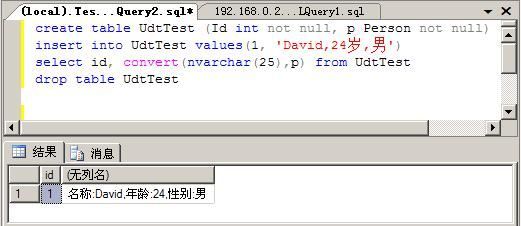
想看清楚SQLCLR在对UDT处理机制可以将项目附加到SQL Server 2005进程,在相应的方法设置断点。

对于.net来讲触发器也是方法,在上方标注[Microsoft.SqlServer.Server.SqlTrigger]标签(只我这样翻译)。
我们看一个小例子
 using
System;
using
System; using
System.Data;
using
System.Data; using
System.Data.Sql;
using
System.Data.Sql; using
Microsoft.SqlServer.Server;
using
Microsoft.SqlServer.Server; using
System.Data.SqlClient;
using
System.Data.SqlClient;
 public
partial
class
Triggers
public
partial
class
Triggers

 {
{ //Name触发器的名字
//Name触发器的名字 //Target触发器对应表
//Target触发器对应表 //Event可以是{ FOR | AFTER | INSTEAD OF } { [ INSERT ] [ , ] [ UPDATE ] [ , ] [ DELETE ] }
//Event可以是{ FOR | AFTER | INSTEAD OF } { [ INSERT ] [ , ] [ UPDATE ] [ , ] [ DELETE ] } [Microsoft.SqlServer.Server.SqlTrigger(Name = "NameInfoTrigger", Target = "NameInfo", Event = "FOR UPDATE")]
[Microsoft.SqlServer.Server.SqlTrigger(Name = "NameInfoTrigger", Target = "NameInfo", Event = "FOR UPDATE")] public static void GetChange()
public static void GetChange()

 {
{ using (SqlConnection cn = new SqlConnection())
using (SqlConnection cn = new SqlConnection())

 {
{ cn.ConnectionString = "context connection=true";
cn.ConnectionString = "context connection=true"; cn.Open();
cn.Open(); using (SqlCommand cmd = cn.CreateCommand())
using (SqlCommand cmd = cn.CreateCommand())

 {
{ cmd.CommandText = "insert into ChangeHistory select b.name + '->' + a.name,getdate() from INSERTED a JOIN DELETED b ON a.id = b.id";
cmd.CommandText = "insert into ChangeHistory select b.name + '->' + a.name,getdate() from INSERTED a JOIN DELETED b ON a.id = b.id"; SqlContext.Pipe.ExecuteAndSend(cmd);
SqlContext.Pipe.ExecuteAndSend(cmd); }
} }
} }
} }
}

右键部署
数据库里的两张表

我执行两条UPDATE语句
 update
[
NameInfo
]
set
[
name
]
=
'
David
'
where
id
=
1
update
[
NameInfo
]
set
[
name
]
=
'
David
'
where
id
=
1
 update
[
nameinfo
]
set
[
name
]
=
'
Fan
'
where
id
=
2
update
[
nameinfo
]
set
[
name
]
=
'
Fan
'
where
id
=
2

再执行两条
 update
[
NameInfo
]
set
[
name
]
=
'
*David*
'
where
id
=
1
update
[
NameInfo
]
set
[
name
]
=
'
*David*
'
where
id
=
1
 update
[
nameinfo
]
set
[
name
]
=
'
*Fan*
'
where
id
=
2
update
[
nameinfo
]
set
[
name
]
=
'
*Fan*
'
where
id
=
2

SQLCLR(四)用户定义类型UDT
用户自定义类型是SQL Server 2005的新特性。和前几篇文章介绍的SQLCLR相比,UDT相对有此复杂。UDT也有许多限制和必须遵守UDT规范。UDT的二进制不能超过8000个字节,必须包含一个null值表示,因为SQLServer的数据类型是允许null值的。
UDT可以是结构或类。如果是类的话需加[StructLayout(LayoutKind.Sequential)]
标签(属性),这是保证序列化时不改变属性的次序。
现在看一段代码
 using
System;
using
System; using
System.IO;
using
System.IO; using
System.Data;
using
System.Data; using
System.Data.SqlClient;
using
System.Data.SqlClient; using
System.Data.SqlTypes;
using
System.Data.SqlTypes; using
Microsoft.SqlServer.Server;
using
Microsoft.SqlServer.Server;
 [Serializable]
[Serializable] [Microsoft.SqlServer.Server.SqlUserDefinedType(Format.UserDefined, MaxByteSize
=
1024
)]
[Microsoft.SqlServer.Server.SqlUserDefinedType(Format.UserDefined, MaxByteSize
=
1024
)] public
struct
Person : INullable, IBinarySerialize
public
struct
Person : INullable, IBinarySerialize

 {
{ public override string ToString()
public override string ToString()

 {
{ // 用您的代码替换下列代码
// 用您的代码替换下列代码 return FormatU();
return FormatU(); }
}
 public bool IsNull
public bool IsNull

 {
{ get
get

 {
{ // 在此处放置代码
// 在此处放置代码 return m_Null;
return m_Null; }
} }
}
 public static Person Null
public static Person Null

 {
{ get
get

 {
{ Person h = new Person();
Person h = new Person(); h.m_Null = true;
h.m_Null = true; return h;
return h; }
} }
}
 public static Person Parse(SqlString s)
public static Person Parse(SqlString s)

 {
{ if (s.IsNull)
if (s.IsNull) return Null;
return Null;
 Person u = new Person();
Person u = new Person(); string value = s.Value;
string value = s.Value; if (value == "null") return Null;
if (value == "null") return Null;
 string[] parts = value.Split(',');
string[] parts = value.Split(','); u.name = parts[0];
u.name = parts[0]; u.age = ParseAge(parts[1]);
u.age = ParseAge(parts[1]); u.sex = parts[2];
u.sex = parts[2]; return u;
return u; }
}
 // 这是占位符方法
// 这是占位符方法 public string FormatU()
public string FormatU()

 {
{ //在此处插入方法代码
//在此处插入方法代码 return string.Format("名称:{0},年龄:{1},性别:{2}", name, age, sex);
return string.Format("名称:{0},年龄:{1},性别:{2}", name, age, sex); }
}
 // 这是占位符静态方法
// 这是占位符静态方法 public static int ParseAge(string str)
public static int ParseAge(string str)

 {
{ //在此处插入方法代码
//在此处插入方法代码 return int.Parse(str.Substring(0, str.LastIndexOf("岁")));
return int.Parse(str.Substring(0, str.LastIndexOf("岁"))); }
}
 // 这是占位符字段成员
// 这是占位符字段成员 private int age;
private int age; public int Age
public int Age

 {
{
 get
get  { return age; }
{ return age; }
 set
set  { age = value; }
{ age = value; } }
}
 private string name;
private string name; public string Name
public string Name

 {
{
 get
get  { return name; }
{ return name; }
 set
set  { name = value; }
{ name = value; } }
}
 private string sex;
private string sex; public string Sex
public string Sex

 {
{
 get
get  { return sex; }
{ return sex; }
 set
set  { sex = value; }
{ sex = value; } }
}
 // 私有成员
// 私有成员 private bool m_Null;
private bool m_Null; public byte[] b;
public byte[] b;
 public void Read(BinaryReader r)
public void Read(BinaryReader r)

 {
{ name = r.ReadString();
name = r.ReadString(); sex = r.ReadString();
sex = r.ReadString(); age = r.ReadInt32();
age = r.ReadInt32(); m_Null = r.ReadBoolean();
m_Null = r.ReadBoolean(); }
} public void Write(BinaryWriter w)
public void Write(BinaryWriter w)

 {
{ w.Write(name);
w.Write(name); w.Write(sex);
w.Write(sex); w.Write(age);
w.Write(age); w.Write(m_Null);
w.Write(m_Null); }
} }
}



部署后在SQL Server 2005中执行下面的语句
 create
table
UdtTest (Id
int
not
null
, p Person
not
null
)
create
table
UdtTest (Id
int
not
null
, p Person
not
null
) insert
into
UdtTest
values
(
1
,
'
David,24岁,男
'
)
insert
into
UdtTest
values
(
1
,
'
David,24岁,男
'
) select
id,
convert
(
nvarchar
(
25
),p)
from
UdtTest
select
id,
convert
(
nvarchar
(
25
),p)
from
UdtTest drop
table
UdtTest
drop
table
UdtTest


想看清楚SQLCLR在对UDT处理机制可以将项目附加到SQL Server 2005进程,在相应的方法设置断点。

SQLCLR(五)聚合
SQL Server中的聚合,常用的比如max,count之类。 我们现在也可以在SQLCLR里创建自定义的聚合。Visual Studio 2005中提供的聚合模板是一个结构,标注了[Serializable],[SqlUserDefinedAggregate]标签,这将让SQLCLR知道这是一个聚合函数。
看一段代码,这段代码来自SQL Server 2005联机丛书,本来自己想写一段,但突然公司有些事要做,没时间了。示例代码作用是合并同一部书(ID相同)的作者。
 using
System;
using
System;
 using
System.Data;
using
System.Data;
 using
Microsoft.SqlServer.Server;
using
Microsoft.SqlServer.Server;
 using
System.Data.SqlTypes;
using
System.Data.SqlTypes;
 using
System.IO;
using
System.IO;
 using
System.Text;
using
System.Text;

 [Serializable]
[Serializable]
 [SqlUserDefinedAggregate(
[SqlUserDefinedAggregate(
 Format.UserDefined,
//
use clr serialization to serialize the intermediate result
Format.UserDefined,
//
use clr serialization to serialize the intermediate result
 IsInvariantToNulls
=
true
,
//
optimizer property
IsInvariantToNulls
=
true
,
//
optimizer property
 IsInvariantToDuplicates
=
false
,
//
optimizer property
IsInvariantToDuplicates
=
false
,
//
optimizer property
 IsInvariantToOrder
=
false
,
//
optimizer property
IsInvariantToOrder
=
false
,
//
optimizer property
 MaxByteSize
=
8000
)
//
maximum size in bytes of persisted value
MaxByteSize
=
8000
)
//
maximum size in bytes of persisted value
 ]
]
 public
class
Concatenate : IBinarySerialize
public
class
Concatenate : IBinarySerialize


 {
{

 /**//// <summary>
/**//// <summary>
 /// The variable that holds the intermediate result of the concatenation
/// The variable that holds the intermediate result of the concatenation
 /// </summary>
/// </summary>
 private StringBuilder intermediateResult;
private StringBuilder intermediateResult;


 /**//// <summary>
/**//// <summary>
 /// Initialize the internal data structures
/// Initialize the internal data structures
 /// </summary>
/// </summary>
 public void Init()
public void Init()


 {
{
 this.intermediateResult = new StringBuilder();
this.intermediateResult = new StringBuilder();
 }
}


 /**//// <summary>
/**//// <summary>
 /// Accumulate the next value, not if the value is null
/// Accumulate the next value, not if the value is null
 /// </summary>
/// </summary>
 /// <param name="value"></param>
/// <param name="value"></param>
 public void Accumulate(SqlString value)
public void Accumulate(SqlString value)


 {
{
 if (value.IsNull)
if (value.IsNull)


 {
{
 return;
return;
 }
}

 this.intermediateResult.Append(value.Value).Append(',');
this.intermediateResult.Append(value.Value).Append(',');
 }
}


 /**//// <summary>
/**//// <summary>
 /// Merge the partially computed aggregate with this aggregate.
/// Merge the partially computed aggregate with this aggregate.
 /// </summary>
/// </summary>
 /// <param name="other"></param>
/// <param name="other"></param>
 public void Merge(Concatenate other)
public void Merge(Concatenate other)


 {
{
 this.intermediateResult.Append(other.intermediateResult);
this.intermediateResult.Append(other.intermediateResult);
 }
}


 /**//// <summary>
/**//// <summary>
 /// Called at the end of aggregation, to return the results of the aggregation.
/// Called at the end of aggregation, to return the results of the aggregation.
 /// </summary>
/// </summary>
 /// <returns></returns>
/// <returns></returns>
 public SqlString Terminate()
public SqlString Terminate()


 {
{
 string output = string.Empty;
string output = string.Empty;
 //delete the trailing comma, if any
//delete the trailing comma, if any
 if (this.intermediateResult != null
if (this.intermediateResult != null
 && this.intermediateResult.Length > 0)
&& this.intermediateResult.Length > 0)


 {
{
 output = this.intermediateResult.ToString(0, this.intermediateResult.Length - 1);
output = this.intermediateResult.ToString(0, this.intermediateResult.Length - 1);
 }
}

 return new SqlString(output);
return new SqlString(output);
 }
}

 public void Read(BinaryReader r)
public void Read(BinaryReader r)


 {
{
 intermediateResult = new StringBuilder(r.ReadString());
intermediateResult = new StringBuilder(r.ReadString());
 }
}

 public void Write(BinaryWriter w)
public void Write(BinaryWriter w)


 {
{
 w.Write(this.intermediateResult.ToString());
w.Write(this.intermediateResult.ToString());
 }
}
 }
这里有几个比较重要的方法:Terminate,这个方法是聚合最后调用的方法,它返回最后的值。可以是SQL Server的任何标量。;Accumulate,聚合每处理一行数据的时候都会调用一次,并将要处理的数据传给方法。可以在函数内部进行比如比较,合并之类的处理。;
}
这里有几个比较重要的方法:Terminate,这个方法是聚合最后调用的方法,它返回最后的值。可以是SQL Server的任何标量。;Accumulate,聚合每处理一行数据的时候都会调用一次,并将要处理的数据传给方法。可以在函数内部进行比如比较,合并之类的处理。;
 CREATE
TABLE
BookAuthors
CREATE
TABLE
BookAuthors
 (
(
 BookID
int
NOT
NULL
,
BookID
int
NOT
NULL
,
 AuthorName
nvarchar
(
200
)
NOT
NULL
AuthorName
nvarchar
(
200
)
NOT
NULL
 )
)

 INSERT
BookAuthors
VALUES
(
1
,
'
Johnson
'
)
INSERT
BookAuthors
VALUES
(
1
,
'
Johnson
'
)
 INSERT
BookAuthors
VALUES
(
2
,
'
Taylor
'
)
INSERT
BookAuthors
VALUES
(
2
,
'
Taylor
'
)
 INSERT
BookAuthors
VALUES
(
3
,
'
Steven
'
)
INSERT
BookAuthors
VALUES
(
3
,
'
Steven
'
)
 INSERT
BookAuthors
VALUES
(
2
,
'
Mayler
'
)
INSERT
BookAuthors
VALUES
(
2
,
'
Mayler
'
)
 INSERT
BookAuthors
VALUES
(
3
,
'
Roberts
'
)
INSERT
BookAuthors
VALUES
(
3
,
'
Roberts
'
)
 INSERT
BookAuthors
VALUES
(
3
,
'
Michaels
'
)
INSERT
BookAuthors
VALUES
(
3
,
'
Michaels
'
)

 SELECT
BookID, dbo.MyAgg(AuthorName)
SELECT
BookID, dbo.MyAgg(AuthorName)
 FROM
BookAuthors
FROM
BookAuthors
 GROUP
BY
BookID
GROUP
BY
BookID
 结果如下
结果如下
Microsoft SQL Server Management Studio为我们提供了数据库内对象的集中管理功能,前面几篇创建的SQLCLR对象,都可以在数据库的可编程性下相应模块里找到。

看一段代码,这段代码来自SQL Server 2005联机丛书,本来自己想写一段,但突然公司有些事要做,没时间了。示例代码作用是合并同一部书(ID相同)的作者。
 using
System;
using
System; using
System.Data;
using
System.Data; using
Microsoft.SqlServer.Server;
using
Microsoft.SqlServer.Server; using
System.Data.SqlTypes;
using
System.Data.SqlTypes; using
System.IO;
using
System.IO; using
System.Text;
using
System.Text;
 [Serializable]
[Serializable] [SqlUserDefinedAggregate(
[SqlUserDefinedAggregate( Format.UserDefined,
//
use clr serialization to serialize the intermediate result
Format.UserDefined,
//
use clr serialization to serialize the intermediate result
 IsInvariantToNulls
=
true
,
//
optimizer property
IsInvariantToNulls
=
true
,
//
optimizer property
 IsInvariantToDuplicates
=
false
,
//
optimizer property
IsInvariantToDuplicates
=
false
,
//
optimizer property
 IsInvariantToOrder
=
false
,
//
optimizer property
IsInvariantToOrder
=
false
,
//
optimizer property
 MaxByteSize
=
8000
)
//
maximum size in bytes of persisted value
MaxByteSize
=
8000
)
//
maximum size in bytes of persisted value
 ]
] public
class
Concatenate : IBinarySerialize
public
class
Concatenate : IBinarySerialize

 {
{
 /**//// <summary>
/**//// <summary> /// The variable that holds the intermediate result of the concatenation
/// The variable that holds the intermediate result of the concatenation /// </summary>
/// </summary> private StringBuilder intermediateResult;
private StringBuilder intermediateResult;

 /**//// <summary>
/**//// <summary> /// Initialize the internal data structures
/// Initialize the internal data structures /// </summary>
/// </summary> public void Init()
public void Init()

 {
{ this.intermediateResult = new StringBuilder();
this.intermediateResult = new StringBuilder(); }
}

 /**//// <summary>
/**//// <summary> /// Accumulate the next value, not if the value is null
/// Accumulate the next value, not if the value is null /// </summary>
/// </summary> /// <param name="value"></param>
/// <param name="value"></param> public void Accumulate(SqlString value)
public void Accumulate(SqlString value)

 {
{ if (value.IsNull)
if (value.IsNull)

 {
{ return;
return; }
}
 this.intermediateResult.Append(value.Value).Append(',');
this.intermediateResult.Append(value.Value).Append(','); }
}

 /**//// <summary>
/**//// <summary> /// Merge the partially computed aggregate with this aggregate.
/// Merge the partially computed aggregate with this aggregate. /// </summary>
/// </summary> /// <param name="other"></param>
/// <param name="other"></param> public void Merge(Concatenate other)
public void Merge(Concatenate other)

 {
{ this.intermediateResult.Append(other.intermediateResult);
this.intermediateResult.Append(other.intermediateResult); }
}

 /**//// <summary>
/**//// <summary> /// Called at the end of aggregation, to return the results of the aggregation.
/// Called at the end of aggregation, to return the results of the aggregation. /// </summary>
/// </summary> /// <returns></returns>
/// <returns></returns> public SqlString Terminate()
public SqlString Terminate()

 {
{ string output = string.Empty;
string output = string.Empty; //delete the trailing comma, if any
//delete the trailing comma, if any if (this.intermediateResult != null
if (this.intermediateResult != null && this.intermediateResult.Length > 0)
&& this.intermediateResult.Length > 0)

 {
{ output = this.intermediateResult.ToString(0, this.intermediateResult.Length - 1);
output = this.intermediateResult.ToString(0, this.intermediateResult.Length - 1); }
}
 return new SqlString(output);
return new SqlString(output); }
}
 public void Read(BinaryReader r)
public void Read(BinaryReader r)

 {
{ intermediateResult = new StringBuilder(r.ReadString());
intermediateResult = new StringBuilder(r.ReadString()); }
}
 public void Write(BinaryWriter w)
public void Write(BinaryWriter w)

 {
{ w.Write(this.intermediateResult.ToString());
w.Write(this.intermediateResult.ToString()); }
} }
}
 CREATE
TABLE
BookAuthors
CREATE
TABLE
BookAuthors (
( BookID
int
NOT
NULL
,
BookID
int
NOT
NULL
, AuthorName
nvarchar
(
200
)
NOT
NULL
AuthorName
nvarchar
(
200
)
NOT
NULL
 )
)
 INSERT
BookAuthors
VALUES
(
1
,
'
Johnson
'
)
INSERT
BookAuthors
VALUES
(
1
,
'
Johnson
'
) INSERT
BookAuthors
VALUES
(
2
,
'
Taylor
'
)
INSERT
BookAuthors
VALUES
(
2
,
'
Taylor
'
) INSERT
BookAuthors
VALUES
(
3
,
'
Steven
'
)
INSERT
BookAuthors
VALUES
(
3
,
'
Steven
'
) INSERT
BookAuthors
VALUES
(
2
,
'
Mayler
'
)
INSERT
BookAuthors
VALUES
(
2
,
'
Mayler
'
) INSERT
BookAuthors
VALUES
(
3
,
'
Roberts
'
)
INSERT
BookAuthors
VALUES
(
3
,
'
Roberts
'
) INSERT
BookAuthors
VALUES
(
3
,
'
Michaels
'
)
INSERT
BookAuthors
VALUES
(
3
,
'
Michaels
'
)
 SELECT
BookID, dbo.MyAgg(AuthorName)
SELECT
BookID, dbo.MyAgg(AuthorName) FROM
BookAuthors
FROM
BookAuthors GROUP
BY
BookID
GROUP
BY
BookID
| BookID | Author Names |
|---|---|
| 1 |
Johnson |
| 2 |
Taylor, Mayler |
| 3 |
Roberts, Michaels, Steven |
Microsoft SQL Server Management Studio为我们提供了数据库内对象的集中管理功能,前面几篇创建的SQLCLR对象,都可以在数据库的可编程性下相应模块里找到。
